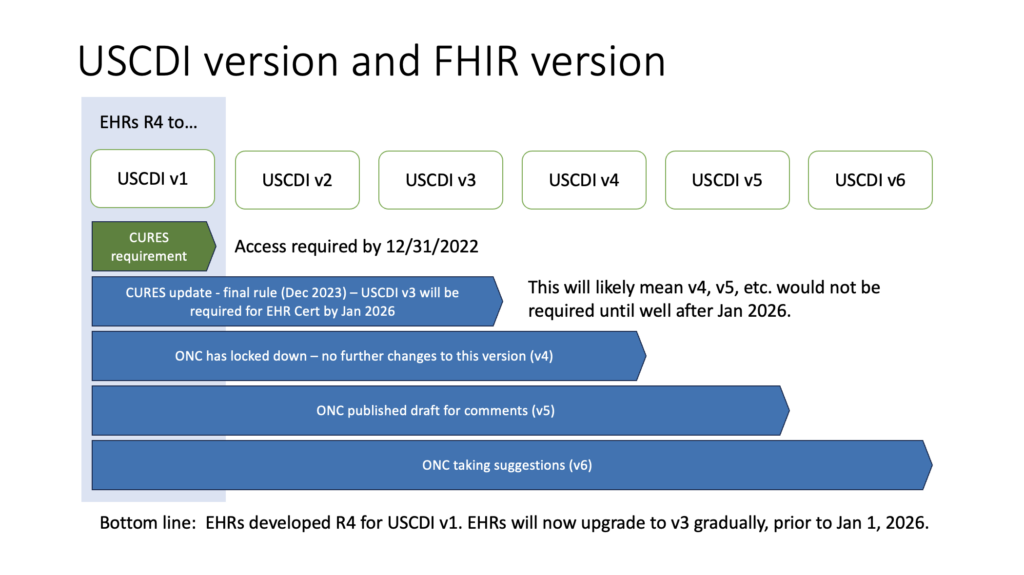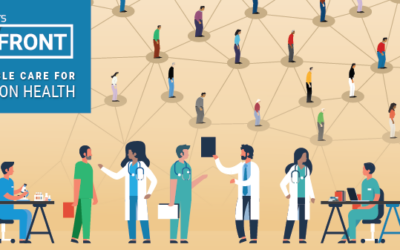By: Steve Emery, Senior Director of Product Management
The current state of electronic health records (EHR) standards always comes up when Greenlight speaks with customers and prospects. It makes sense that they want to be sure their data will comply with mandated standards.
To that end, Greenlight customers often ask specifically about FHIR R4 and USCDI. They want to know if the R4 data is up to date regarding the USCDI standard mandated by the Office of the National Coordinator for Health Information Technology (ONCHIT, usually abbreviated as just ONC).
It’s a good question. The answer has layers.
First, some definitions, so we’re clear what we’re talking about.
- FHIR R4 (Fast Healthcare Interoperability Resources) is a standard for arranging and transferring the data. The R4 is “Release #4”. FHIR defines what medical record data goes where in the json file that gets shared by EHRs and health facilities. It has rules for which pieces of data are “required” when an EHR is sharing say, a medication, or a diagnosis (a “condition”). What FHIR doesn’t do is mandate what portions of the medical record must be shared. That’s where USCDI comes in.
- USCDI (US Core Data for Interoperability) is a list of the minimum data types which must be shared if an EHR is going to be “certified” as interoperable, and the facility using it is going to be eligible for the CMS reimbursement bonuses available only to certified EHR users.
Think of FHIR R4 as the “how” and “where” of sharing. USCDI is the “what” of sharing.
Second, what USCDI version are we using today?
Currently the “law of the land” is FHIR R4 populated according to USCDI v1. That’s the version mandated originally under the CURES Act.
ONC runs a continuous process to define the next “versions” of USCDI. Interestingly ONC is working actively on versions 5 and 6, as of this writing. But the law today still only mandates version 1.
On January 9, 2024, ONC published the final rule mandating a future update to USCDI version 3. EHRs must be sharing using USCDI version 3’s rules, by January 1, 2026, to stay “certified.”
The illustration below shows how ONC progresses through USCDI versions, and how this relates to what you can expect in FHIR R4 data from most EHRs today. As you can see, only USCDI v1 is enforced today (“CURES requirement”).

What does this mean for a customer getting FHIR R4 data from the Greenlight platform?
- Greenlight retrieves all the FHIR R4 resources the EHR makes available. If the health facility is using Epic’s EHR, for example, Greenlight will retrieve every FHIR resource Epic makes available for patient access. This means the set of data defined by USCDI v1.
- As we approach January 1, 2026, EHRs will begin to add the data required under USCDI v3. This is a modest boost, adding only a small set of additional fields. Links below let you compare the gains for yourself. As EHRs add these “to be” required data fields, Greenlight is monitoring for these additions and will retrieve any new FHIR resources and any new data elements that show up in those resources. These updates will appear in our API where you will be able to retrieve them. We expect EHRs will roll out USCDI v3 gradually, and for some EHRs (like Epic) it may even vary over time from one health system to another, as the sites apply the Epic updates.
- By January 1, 2026, ONC may propose another version of FHIR (beyond R4) and maybe the next “required” version of USCDI, but they will give the EHRs months (18-24, typically) to implement that change. That could possibly take us to 2028. Greenlight will continue to stay ahead of these changes, monitoring the EHRs and the data that’s available.
In summary
- Greenlight always gets all the FHIR R4 data made available by the EHR and by the facility
- As the EHRs share more data (complying with USCDI v3 by Jan 1, 2026), Greenlight will get and share that data through our normal API process
For more information
Please contact us with any questions regarding compliance with FHIR R4 and USCDI requirements, or to discuss how you can advance the electronic health data revolution in your organization.



